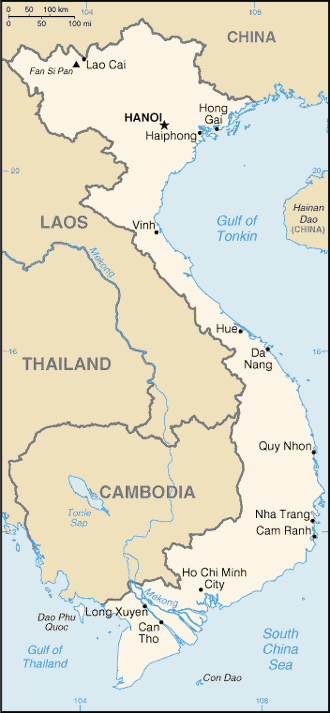Map:

Overview:
The conquest of Vietnam by France began in 1858 and was completed by 1884. It became part of French Indochina in 1887. Independence was declared after World War II, but the French continued to rule until 1954 when they were defeated by Communist forces under Ho Chi MINH, who took control of the North. US economic and military aid to South Vietnam grew through the 1960s in an attempt to bolster the government, but US armed forces were withdrawn following a cease-fire agreement in 1973. Two years later, North Vietnamese forces overran the South. Despite the return of peace, for over two decades the country experienced little economic growth because of conservative leadership policies. Since 2001, Vietnamese authorities have committed to economic liberalization and enacted structural reforms needed to modernize the economy and to produce more competitive, export-driven industries. The country continues to experience protests from the Montagnard ethnic minority population of the Central Highlands over loss of land to Vietnamese settlers and religious persecution.
The People:
Population: 83,535,576 (July 2005 est.)
Age structure:
0-14 years: 27.9% (male 12,065,777/female 11,212,299)
15-64 years: 66.4% (male 27,406,456/female 28,024,250)
65 years and over: 5.8% (male 1,889,585/female 2,937,209) (2005 est.)
Religions:
Buddhist 9.3%, Catholic 6.7%, Hoa Hao 1.5%, Cao Dai 1.1%, Protestant 0.5%, Muslim 0.1%, none 80.8% (1999 census)
Government Type:
Communist state
Leader(s) to pray for:
chief of state: President Tran Duc LUONG (since 24 September 1997)
head of government: Prime Minister Phan Van KHAI (since 25 September 1997); First Deputy Prime Minister Nguyen Tan DUNG (since 29 September 1997); Deputy Prime Ministers Vu KHOAN (8 August 2002) and Pham Gia KHIEM (since 29 September 1997)
Source: The World Factbook
View All Countries